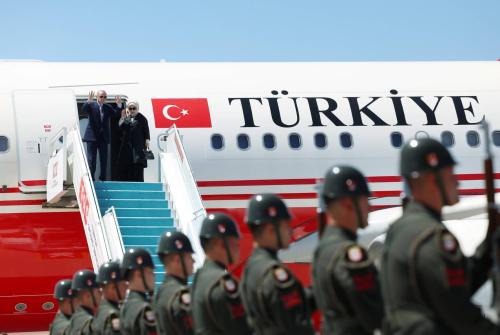In a Jan. 22 letter to secretaries Hagel (Defense) and Kerry (State), Reps. Mike Rogers (R-Ala.) and Mike Turner (R-Ohio) expressed concern about the deployment of Russian nuclear weapons to Crimea. They asked Hagel and Kerry to consider developing sites in Eastern Europe to house dual-capable aircraft (which can carry nuclear and conventional weapons) and B61 nuclear bombs. Their concern is understandable. There are, however, smarter ways to respond.
Russia illegally occupied, and then annexed, Crimea in March 2014. The Kremlin asserts that, since Crimea now supposedly is a part of Russia—a claim virtually no one outside of Moscow accepts—there is no prohibition on placing nuclear weapons there.
Vladimir Putin has approved basing two dual-capable systems in Crimea: the Iskander-M short-range ballistic missile and Backfire bomber. It is not clear, however, whether the Iskander missile has been deployed, and the Russian defense ministry has said it does not plan to deploy the Backfire until 2016. There is a separate question as to whether the Russians have deployed or will deploy in Crimea nuclear warheads for these systems.
As the Ukraine crisis has played out, Putin has engaged in nuclear chest-thumping. Why is not clear. Who does not understand that Russia has lots of nuclear weapons? Part of the reason may be that the nuclear arsenal is Moscow’s sole claim to superpower status.
According to the Federation of American Scientists, the United States has 160-200 B61 nuclear bombs at six airfields in Germany, Belgium, the Netherlands, Italy and Turkey. The Rogers/Turner letter seeks information about hardened aircraft shelters and building B61 storage vaults at airfields in Eastern Europe, i.e., closer to Russia.
Building those facilities in Eastern Europe—and seeking to base dual-capable aircraft and B61 bombs there—would, however, be unwise.
First, locating dual-capable aircraft and B61 bombs in Eastern Europe would put them much closer to Russian territory and make them more vulnerable to preemptive attack. For example, basing such weapons in the Baltic states or many parts of Poland would put them in range of the Iskander missiles that the Russians have deployed in Kaliningrad.
Second, placing nuclear weapons in such close proximity to Russia would be seen as highly provocative (think 1962 and the Soviet placement of nuclear missiles in Cuba). And were the U.S. Air Force to build the sites but keep the aircraft and bombs at their current bases, there is little chance they would forward deploy in a crisis; it would be seen as too incendiary a step.
Third, many allies would question the wisdom of and oppose deploying nuclear weapons in Eastern Europe, which would contradict NATO policy. In 1997, NATO stated that, as it enlarged, it had “no intention, no plan and no reason” to deploy nuclear arms on the territory of new member states. While some allies have suggested the Alliance revisit its parallel pledge on no permanent stationing of substantial combat forces on the territory of new allies, no ally has seriously raised the idea of altering the three nuclear no’s.
Fourth, building and maintaining hardened aircraft shelters, B61 vaults and associated infrastructure would consume scarce defense resources that could be put to better use.
There are smarter ways to respond to Russia’s egregious behavior.
The United States should provide significant military assistance, including defensive arms, to the Ukrainian military on an urgent basis. Congress overwhelmingly approved the Ukraine Freedom Support Act in December. The Act authorizes $350 million over three years. More is needed, and funds should be appropriated, not just authorized.
Congress should support a more robust conventional U.S. presence in Eastern Europe. The U.S. Army intends to deploy an armored brigade’s worth of Abrams tanks and Bradley armored fighting vehicles to Europe, perhaps Poland. Congress should ensure that action is adequately funded and should ask the administration about other steps to bolster conventional U.S. capabilities in Europe.
Congress should ensure funding for the persistent deployment of U.S. Army units to the Baltic states and Poland that began last April. “Persistent” should become the new “permanent.” Members of Congress in the North Atlantic Parliamentary Assembly should urge their European colleagues to provide sufficient funding for NATO’s Rapid Reaction Force and ask that European militaries deploy alongside American units.
Russia’s aggression against Ukraine demands a strong Western response. But an action that would make U.S. nuclear weapons more vulnerable to preemption and divide the Alliance is not the way to go. Strengthening U.S. conventional military power in Eastern Europe makes far more sense.
This piece was originally published in
The Hill
.
The Brookings Institution is committed to quality, independence, and impact.
We are supported by a diverse array of funders. In line with our values and policies, each Brookings publication represents the sole views of its author(s).



Commentary
Op-edRussian Nukes in Crimea? A Better Way to Respond
February 2, 2015